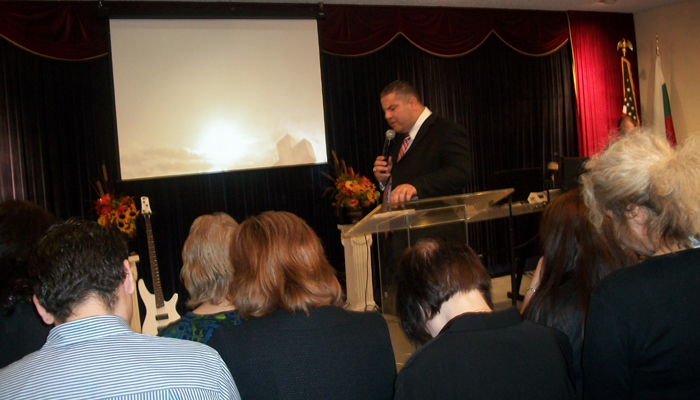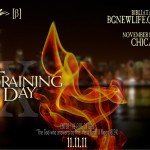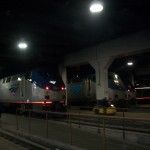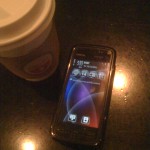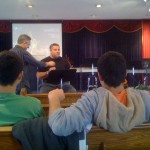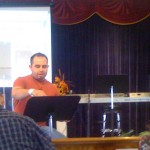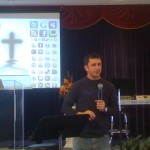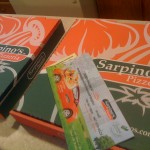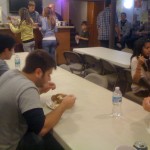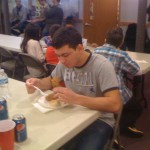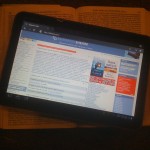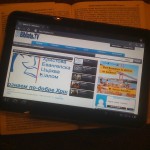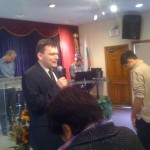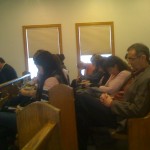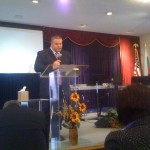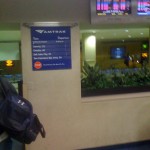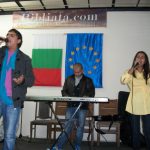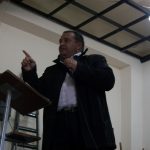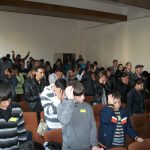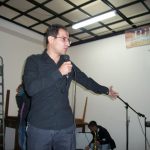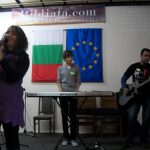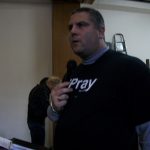Bulgaria in Pictures: Nature
[slideshow]
Thankful for Everything in 2011
What a year we have had! Started with the winter in Cleveland, which blocked us with snow for three days. We are used to the snow in Bulgaria, but who would’ve expected the South to freeze over.
Then, in the spring we had a Tornado season for the first time in Tennessee. Our place was damaged by wind and water and both of our vehicles totaled. Our Volvo was smashed under then a 50-foot tree only a few miles short of the 300,000 mile record. All this happening right before our leaving for Bulgaria.
But we have to do what God wants us to do, and a week after the storm we were on our way to Bulgaria via London, where we preached the first ever conference for Bulgarian churches in Western Europe with a dozen congregations in attendance.
Returning to Bulgaria in the beginning of the summer, we held our annual youth camp in the mountains and shortly afterwards taught the final module of the masters’ chaplaincy program, which we began several years ago. We then celebrated 15 years of ministry on the internet, while preaching among churches and friends of some 100 congregations in Bulgaria.
We were able to continue with our vision for ministry among the Bulgarian youth on 11.11.11 at the Bulgarian Church in Chicago, and then were invited to guest lecture on the political situation in Eastern Europe at the University of Nebraska.
As God has seen us through the snowy storms, furious tornados, scorching summer, several earthquakes and a tropical rain fall, while traveling and ministering around the globe before returning back to the United States, we are truly thankful for the opportunity to preach the Gospel. Thank you all for your prayers and support!
Lesson learned in 2011: You will never know God, as the Lord of the storms, until you walk with Him through the storms in your life! For Jesus said: “Let’s go over to the other side…” (Luke 8:22)
In the Torch Again
X 11.11.11 Youth Event Afterglow
X Youth Event: 11.11.11 LIVE from Chicago
AZUSA STREET AND FRANK BARTLEMAN
 An Eyewitness to Azusa Street
An Eyewitness to Azusa Street
INTRODUCTION by Vinson Synan
Few events have affected modern church history as greatly as the famous Azusa Street revival of 1900-1909, which ushered into being the worldwide twentieth-century Pentecostal renewal. From this single revival has issued a movement which by 1980 numbers over 50,000,000 classical Pentecostals in uncounted churches and missions in practically every nation of the world. In addition to these Pentecostals, there are untold numbers of charismatics in every denomination who can trace at least part of their spiritual heritage to the Azusa Street meeting.
WILLIAM J. SEYMOUR
It was in Houston that a Southern black holiness preacher by the name of William J. Seymour joined Parham’s Bible school. Despite the Jim Crow segregation laws of the South, Seymour joined in the classes taught by Parham. Originally a Baptist, Seymour had entered the ranks of the holiness movement before 1905 and freely accepted Parham’s cardinal teachings which now included five points: justification, sanctification, baptism in the Holy Spirit with the “initial evidence” of speaking in other tongues, divine healing and the premillennial second coming of Christ.
Although Seymour accepted Parham’s teaching on tongue: (glossolalia), he did not receive the experience in Houston. The mantle of leadership in the fledgling pentecostal movement was soon to be transferred from Parham to Seymour, and the “place of blessing” from Houston to Los Angeles.
In 1906 Seymour received an invitation to preach in a black Nazarene church in Los Angeles pastored by a woman preacher, Reverend Mrs. Huchinson. When he arrived in Los Angeles in the spring of 1906, Seymour found a city of some 228,000 which was growing at a rate of 15 percent a year. Many strange religions and a multiplicity of denominations occupied the religious attentions of the city. Los Angeles was a melting-pot metropolis! with large numbers of Mexicans, Chinese, Russians, Greeks Japanese, Koreans, and Anglo-American inhabitants.
The religious life of the city was dominated by Joseph Smale, whose large First Baptist Church had been transformed into the, “New Testament Church” due to the effects of the Welsh revival which were being felt in Los Angeles at the time. Another important religious influence in the city was Phineas Bresee, who had founded the Pentecostal Church of the Nazarene in 1895 in an attempt to preserve the teaching of holiness which he felt was dying out in the Methodist Church, a denomination in which h had served as a leading minister for some thirty years.
Starting his work at the Peniel Mission in the very poorest section of the city, Bresee was repeating Wesley’s work of a earlier century in England by ministering to the disinherited of Los Angeles society. His Nazarene followers were rapidly becoming the largest holiness church in America.
In the black community, a rich social and religious life had developed during the last years of the century with numbers of Methodist, Baptist, and holiness churches located in the black community that centered around Bonnie Brae Street.
Without question, William J. Seymour was the central figure of the Azusa street revival and will always be remembered as the vessel chosen of the Lord to spark the worldwide Pentecost revival. Yet, little that he wrote has been preserved for posterity.
This fact is not to be despised, however, when one reflects that neither Socrates nor Jesus left a body of written works for future generations to read. Socrates had his Plato to record his dialogue while Jesus had the four evangelists, Matthew, Mark, Luke, and John, to leave a written record of His teachings. Seymour had his Frank Bartleman.
It was Bartleman’s diary and reports in the holiness press that constituted the most complete and reliable record of what occurred at Azusa Street. In later years, Bartleman gathered together his diary entries and articles written to various periodicals and published them in book form.
In this book, entitled “How Pentecost Came to Los Angeles,” one feels the excitement of the events at the old Azusa mission. From the beginning, Bartleman seemed to sense the historic significance of the Los Angeles Pentecost. From the first meeting he attended in April 1906, he felt that a “world wide revival” would be the result.
In many ways, Bartleman’s entire life had been spent in preparation for reporting the Azusa Street meeting. It is probable that without his reporting, the Pentecostal movement would not have spread so quickly and so far as it did. His journalism not only informed the world about the Pentecostal movement, but in a large measure also helped to form it.
Born in Rucks County, Pennsylvania, in 1871 to a German-born Roman Catholic father and an English-born Quaker mother, Bartleman grew up on a farm where his first job was that of following a plow. While he feared his stern father, he enjoyed a tender relationship with his mother. From his earliest days, he suffered from frail health. In his own words he was a “life-long semi-invalid” who “always lived with death looking over my shoulder.”
His conversion took place in October 1893 in the Baptist Temple in Philadelphia, pastored by the famous preacher Russell Conwell, author of the gospel of wealth classic, “Acres of Diamonds. After Conwell baptized the twenty-two-year-old Bartleman, he offered to pay the young man’s way through college. Bartleman refused, explaining that “I made my choice between a popular, paying pulpit and a humble walk of poverty and suffering. . . I choose the streets and slums for my pulpit.”
At the time he licensed to preach, by the Temple Baptist Church, he decided to “trust God” for his body. A lifelong devotion to the doctrine of divine healing followed. The desire to preach was overwhelming. “The Gospel was a fire in my bones that roared all the day,” wrote the young minister.
In 1897 Bartleman left the Baptist ministry and cast his lot with the holiness movement. Joining the Salvation Army, he spent a short time in Johnstown, Pennsylvania, as a captain before disillusionment led him to leave the army. He later traveled to Chicago to attend the Moody Bible Institute.
Bartleman did not study long in Chicago, however. He had wandering feet. Soon he was on a “gospel wagon” making his first tour of the South. Here he befriended the blacks to the consternation of white Southerners. The wandering life occasionally depressed him. On a second tour of the South in 1899 he became so despondent that he once actually contemplated suicide. Later, though, he felt well enough to contemplate matrimony.
In 1900 he married a Miss Ladd, matron of a school for fallen girls in Pittsburgh, Pennsylvania. He also experienced his first spiritual manifestation of “shouting and jumping,” although before this he had led a life of a “rather monkish tendency.”
Soon after marriage, Bartleman was ordained in Philadelphia “in pentecostal connection,” a term which he fails to further explain. This group was probably one of the small holiness groups of the day, who found it popular to use the word “pentecostal” in their name in reference to the second blessing of sanctification through the baptism in the Holy Ghost (without any reference to glossolalia).
Near the time of his marriage he joined the Wesleyan Methodist Church and was assigned a pastorate in Corry, Pennsylvania. This pastorate was an unhappy experience for Bartleman, since he found the church to be “not even spiritual” and, in his judgment, a “backslidden holiness charge.”
In this period, Bartleman was subject to several more mystic experiences in addition to his shouting and jumping of a few months earlier. In a camp meeting he felt “electric shocks” to the point that he fell unconscious. Later after his horse was healed in answer to prayer, Satan attacked him in his room at night “to destroy me.” The name of Jesus put Satan to flight. Also, after miraculous healing, he was “slain in the Spirit” for one-half hour before a congregation where he had been preaching.
When his father-in-law invited him to join the Methodist Episcopal Conference in New York Bartleman refused. While the Methodist Church was moving away from emotional and expressive holiness religion in this period, Bartleman was moving in the opposite direction. He branded the Methodist Church as being “dead and compromised.”
After leaving the Wesleyan Methodist Church in Pennsylvania, Bartleman set his sights on the West. Working at odd jobs, he led his wife and newly born daughter, Esther, on a trip to Colorado, with California as his eventual goal.
In Denver, he went to work with Alma White, head of the Pillar of Fire church, a small holiness group that specialized in the “holy dance.” It was here that Bartleman was “cured of ever worshipping a religious zeal or creed.”
While in Colorado, Bartleman continued the ministry that became his lifetime mission–work in slum areas among alcoholic and fallen girls. Most of this work was done in the holiness rescue missions that were located in the central areas of the nation’s larger cities.
He also felt compelled to print and distribute tracts as part of his ministry. In addition to tracts, Bartleman often painted Scriptures on bridges, rocks beside the highways, or other public places. Because of these activities he occasionally ran afoul of the law. In 1902 he was arrested in Boulder, Colorado, for painting Scriptures on canyon walls near the city. Beyond these activities the indefatigable evangelist felt led to preach in every saloon and house of prostitution in every city he visited. In Denver that included over a hundred saloons.
It was in 1904 that Bartleman finally reached his goal, California, where he exclaimed, “Here we reached paradise.” His first stop was in Sacramento, where he was immediately placed in charge of the Peniel Mission, a holiness rescue mission in the heart of the city. His work at Peniel failed “because of incompetent workers” and the aggressive proselyting of the rival Burning Bush and Pillar of Fire missions.
After leaving the Peniel Mission, Bartleman frantically tried to reenter the pastoral ministry. An attempt to gain an appointment in the Wesleyan Methodist Church failed, as did an application to Phineas Bresee for a Nazarene pastorate. “None available” was the word from Bresee.
The desperate Bartleman turned to whatever odd jobs he could obtain-painting, picking apples, cutting wood, etc. Things got so bad that their second baby was born in a rescue home. The leaders of the home refused to let the hapless evangelist stay with his wife and baby. Later his wife was reduced to scrounging for food in garbage cans. They could not afford proper clothing, their feet wearing through the soles of their shoes.
By December 1904, Bartleman left Sacramento for Los Angeles, where he was destined to record some of the most stirring events in the history of the church. “The Spirit had led us to Los Angeles for the ‘Latter Rain’ outpouring,” he later wrote in the end of his autobiographical book, “From Plough to Pulpit–From Maine to California.
In Los Angeles, Bartleman went immediately to the Peniel Mission on South Main Street, which was founded and operated by Mrs. Manie Ferguson, author of the hymn “Blessed Quietness.” (P.F. Bresee worked on the Peniel staff before founding the Church of the Nazarene in 1895).
For Bartleman, hardship and tragedy awaited him in Los Angeles. Poverty, sickness, and the death of his oldest child, “Queen Esther,” in January, 1905, left the hapless preacher and his wife grief-stricken but more determined than ever to fulfill their ministry in the “city of the angels.”
Throughout 1905 Bartleman worked with the various holiness churches and missions in the Los Angeles area. But many of the holiness churches had become rigid and negative to any new winds of revival that might begin to blow. In a warning to them, Bartleman confided in his diary “some holiness churches [foremost at that time are going to be surprised to find God passing them by. He will work in channels where they will yield to Him. They must humble themselves for Him to come.”
Indeed the greatest signs of revival in Los Angeles in 1905 were in Methodist and Baptist churches, in particular the Lake Avenue Methodist Church in Pasadena and Los Angeles’s First Baptist Church, pastored by Frank Smale.
The revival in Smale’s church was sparked by news of the great Welsh revival of 1904-05 led by Evan Roberts. A trip to Wales by Smale and an exchange of letters between Bartleman and Evan Roberts demonstrate a direct spiritual link between the move of God in Wales and the Pentecostal outpouring in Los Angeles in 1906.
At this time also, Bartleman began to write articles for the holiness press. His reports from Los Angeles were printed primarily in the “Way of Faith” in Columbia, South Carolina, and “God’s Revivalist” published in Cincinnati, Ohio. From these influential periodicals Bartleman’s stories were republished for other holiness papers around the nation. By 1906 Bartleman had built a reputation in holiness circles as a reliable reporter whose articles emphasized the need of spiritual renewal among all Christians, but among holiness partisans in particular. He was thus in a strategic position to describe the spiritual climate of Los Angeles before the Azusa Street revival and to report the historic events after the Azusa Street meeting began in 1906.
The reports of the Azusa Street revival are contained in a book Bartleman published in 1925 entitled “How Pentecost Came to Los Angeles–As It Was in the Beginning.” This book was written several years after the events of 1906-1909 and was pieced together from the author’s diary and clippings from articles he had written for the holiness press.
In this book, Bartleman injects himself into the story as one of the prime movers of the Azusa Street events. While it is true that Bartleman helped establish the spiritual climate in which the pentecostal movement could flourish in Los Angeles, the crucial role was played by William J. Seymour, pastor of the Azusa Street Mission.
In 1906 Seymour had been invited to preach in a black Nazarene church in Los Angeles pastored by a “Mrs. Hutchinson.” When Seymour preached his first sermon, proclaiming the “initial evidence” theory of the baptism in the Holy Spirit, he was locked out of the Nazarene church. The stranded preacher was then invited to stay in the home of Richard Asbury on Bonnie Brae Street until he could arrange his return to Houston. But Seymour was destined to spend the rest of his life in Los Angeles due to the tremendous revival that began shortly thereafter.
The theory that forced Seymour out of the Nazarene church was new to holiness circles in Los Angeles in 1906. Simply stated, it is that one cannot say that he has been “baptized in the Holy Spirit” without the “initial evidence” of speaking in tongues (as the church had done on the Day of Pentecost). This was an offensive and revolutionary teaching, since practically all Christians claimed to be baptized in the Spirit–evangelicals at the time of conversion and holiness people at the time of their “second blessing” or “entire sanctification.” The teaching of a glossolalia-attested Spirit baptism became the centerpiece of Pentecostal teaching, with Seymour as the apostle of the movement.
Although he had not yet spoken in tongues at the time he was locked out of the Nazarene church, Seymour did soon thereafter in the Asbury home. Home prayer meetings soon gave way to front-porch street meetings which drew hundreds of eager listeners to hear Seymour and his tongue-speaking followers. Soon the crowds became so large that larger quarters were needed for the fast-growing group.
A search of the downtown Los Angeles area turned up an abandoned old building on Azusa Street that had been used variously as a Methodist church, a stable, and a warehouse. In 1906 it was a shambles, but adequate for the band of Pentecostals who began holding services there in April of 1906.
Bartleman first attended services while the group was on Bonnie Brae Street and then followed Seymour to the premises on Azusa Street. The “Los Angeles Times” first reported the Azusa story in April of 1906. Calling tongues a “weird babel” and Seymour’s followers a “sect of fanatics,” the front-page Time’s article created curiosity and bigger crowds for the meeting. The “press wrote us up shamefully” declared Bartleman, “but that only drew more crowds. “The following is part of the Times report of April 18, 1906 (see Appendix A for the complete article).
Breathing strange utterances and mouthing a creed which it would seem no sane mortal could understand, the newest religious sect has started in Los Angeles. Meetings are held in a tumble-down shack on Azusa Street, near San Pedro Street, and devotees of the weird doctrine practice the most fanatical rites, preach the wildest theories and work themselves into a state of mad excitement in their peculiar zeal.
Colored people and a sprinkling of whites compose the congregation, and night is made hideous in the neighborhood by the howlings of the worshippers who spend hours swaying forth and back in a nerve-racking [sic] attitude of prayer and supplication. They claim to have the “gift of tongues,” and to be able to comprehend the babel.
As the revival continued for three and one-half years at Azusa, services were held three times a day-morning, afternoon, and night. Tongues-speaking was the central attraction, but healing of the sick was not far behind. The walls were soon covered with the crutches and canes or those who were miraculously healed. The gift of tongues was soon followed by the gift of interpretation. As time passed Seymour and his followers claimed that all the gifts of the Spirit had been restored to the church.
It soon became apparent that Seymour was the leading personality in the Los Angeles Pentecost. He became pastor of the church and remained so until his death in 1923. Despite the fact that Seymour was black, many of his followers were white. Although at the beginning of the revival blacks predominated, at the height of the meetings whites constituted a majority. The mission later became predominantly black after the whites began organizing their own assemblies in the Los Angeles area after 1906. In regard to the racial situation, Bartleman exulted, “the color line has been washed away in the Blood.”
As the revival continued, it became apparent that Bartleman’s role would be that of reporter to the religious world about the Los Angeles Pentecost. His articles gained a wide audience across America and in other lands. Stories about Azusa Street in “Way of Faith, God’s Revivalist, and Christian Harvester” were passed from hand to hand.
In addition to Bartleman’s reports and the negative comments of the Los Angeles press, Seymour and his Azusa Street leaders began publication of their own paper, entitled “The Apostolic Faith.” It was sent free across the United States to any who desired it. The editor was a white woman who worked in the mission, Florence Crawford. The name was taken from Charles Parham’s Apostolic Faith movement.
The connection between Seymour and Parham was broken, however, in October 1906. Seymour had invited Parham, his “father in the gospel,” to preach in Azusa Street, but Parham’s negative messages and attempts to correct what he saw as abuses led to his expulsion from the church. From that time onward there was a complete rupture between Seymour and Parham that never was healed.
Nothing was able to stop the inexorable momentum of the renewal that issued forth from Azusa Street, however. “Pilgrims to Azusa” came from all parts of the United States, Canada and Europe. They in turn spread the fire in other places. From North Carolina came Gaston Sarnabus Cashwell of the Pentecostal Holiness Church. After a “crucifixion” over his racial attitudes, he asked the Azusa Street blacks to pray for him. According to his testimony, Cashwell received his baptism and “was soon speaking in the German tongue.” A few months afterward in a meeting in Dunn, North Carolina, and a preaching tour of the South, Cashwell led several southern holiness denominations into the Pentecostal fold (the Pentecostal Holiness Church, the Fire-Baptized Holiness Church, The Church of God, the United Holy Church of America, and The Pentecostal Free Will Baptist Church).
C.H. Mason, head of The Church of God in Christ of Memphis, Tennessee, came to Azusa in November 1906 and received the Pentecostal experience. After returning to his church, the majority of the Church of God in Christ was Pentecostalized. In Birmingham, Alabama, M.M. Pinson and H.G. Rodgers, future pillars in the Assemblies of God (organized in 1914), were baptized in the Holy Spirit under Cashwell’s ministry. When Florence Crawford moved to Portland, Oregon, she took the Azusa paper, “Apostolic Faith,” and made that the name for her new Pentecostal denomination.
From Azusa Street, the Pentecostal flame spread to Canada under R.E. McAlistier and A.H. Argue. The “Apostle of Pentecost” to Europe, T.B. Barratt, cancelled a planned trip to Azusa Street after receiving his Pentecost in New York City. Returning to Oslo, Norway, in 1906 he opened the first Pentecostal work in Europe. From his ministry the torch was passed to Sweden, Denmark, England, Germany, and France. Less directly the fire spread to Chile under the ministry of the American Methodist missionary Dr. W.C. Hooevr; to Brazil under the ministries of Daniel Berg and Gunnar Vingren; and to Russia and other Slavic nations under lvan Voronaeff, a Russian Baptist from New York City.
Thus within a short time the Azusa Street Pentecost became a worldwide move of the Holy Spirit. The five major teachings of Azusa Street served as a standard for this first wave of Pentecostals. They were: (1) justification by faith; (2) sanctification as a definite work of grace; (3) the baptism in the Holy Spirit evidenced by speaking in other tongues; (4) divine healing “as in the atonement”; and (5) the personal premillennial rapture of the saints at the second coming of Christ. Though many “winds of doctrine” blew at Azusa Street, Seymour and his followers continued to stress the above teachings throughout the years of the mission’s ministry.
In time, opinion in the religious world became bitterly divided over the Azusa Street revival. Although a significant proportion of the holiness movement accepted the Azusa revival as signaling the long-prayed-for Pentecost, the majority rejected Pentecostalism. The Fundamentalists rejected Pentecostalism and by 1928 had disfellowshiped all Pentecostals from their ranks. The vast majority of mainline Christians either knew little or nothing of the movement, or dismissed it as another heresy among the “holy rollers.”
After seventy-five years it is now possible to gain a better historical perspective concerning the Azusa Street revival. In the years from 1906 to 1909, during the height of the excitement, it was impossible for anyone to be objective about the events and the teachings at the mission. For those who were baptized in the Spirit and spoke in tongues, the meeting was a foretaste of a worldwide revival. For others who rejected Seymour’s teaching, the “winds of perdition” were blowing at the Azusa Street “slum” mission.
The storm of charges and countercharges that swirled around the controversial revival mission made little impression on Seymour and Bartleman. Though they recognized excesses and the occasional intrusion of spiritualists and mediums into the midst, they continued to see the revival as the beginning of a historic awakening. A prime feature of the services was the reading of reports from other cities, states, and nations where the revival was spreading. It was Bartleman’s opinion that the revival unleashed at Azusa Street would be “a world-wide one without doubt.”
While Bartleman extolled the historic dimensions of the new movement, there were others in Los Angeles who were not so sure. By December 1906, Dr. Phineas Bresee, founder of the Church of the Nazarene (known at that time as the Pentecostal Church of the Nazarene) felt compelled to write an editorial in the Nazarene Messenger about the Azusa services. While Bresee lived in Los Angeles near the mission, there is no evidence that he ever attended services on Azusa Street.
In the article, entitled “The Gift of Tongues” (see Appendix C), he referred obliquely to the articles that Bartleman had already sent to the editors of eastern holiness periodicals:
But some parties who had the confidence of editors in the East sufficiently to secure the publication of what they have written, have given such marvelous statements of things as occurring in connection with this thing, that. . . we deem it wise to say a simple word.
Playing down the importance of the Azusa Street phenomenon in Los Angeles, Bresee stated:
Locally it is of small account, being insignificant both in numbers and influence. Instead of being the greatest movement of the times, as represented–in Los Angeles, at least–it is of small moment. It has had, and has now upon the religious life of the city, about as much influence as a pebble thrown into the sea. . .
In the end, Bresee felt that the Azusa Street Pentecostal bordered on fanaticism and heresy by teaching that
Christians are sanctified before they receive the baptism with the Holy Ghost, this baptism being a gift of power upon the sanctified life, and that the essential and necessary evidence of the baptism is the gift of speaking with new tongues, [which he called] a jargon, a senseless mumble. . . a poor mess.
As to the Azusa Street worshipers, the Nazarene leader stated:
There are more or less people whose experience is unsatisfactory, who have never been sanctified wholly, or have lost the precious work out of their hearts, who will run after the hope of exceptional or marvelous things, to their own further undoing.
It is obvious that the “marvelous statements” to which Bresee referred were those that Bartleman was circulating in the holiness press. His view that the movement had as much influence in Los Angeles as “a pebble thrown into the sea” was contradicted by the burgeoning growth of Pentecostal assemblies in the Los Angeles area and the explosive growth of Pentecostalism across the United States. In the end, Bartleman turned out to be a better prophet than Bresee.
Perhaps Bartleman’s prescience came as a result of his life and career prior to 1906. An acute observer, he wrote vividly about everything he saw, and was not averse at judging everything and everyone he saw. His life spanned many important events and turning points of American religious history.
When he joined the “new order of priests” as a Pentecostal, he had no theological problem in accepting the tongues-attested baptism in the Holy Spirit. When the “finished work” view of sanctification was preached by William Durham of Chicago, Bartleman stood at his side and gladly accepted his teachings. A few years later when the “oneness” movement appeared, Bartleman joined with Glenn Cook and Frank Ewart and was rebaptized “in Jesus’ name.”
After joining what the Trinitarian Pentecostals dubbed the “Jesus only” Pentecostal movement, Bartleman lost many friends and former contacts. No longer able to write for holiness or Pentecost periodicals, he lost influence in the movement and became largely isolated except for his “oneness” colleagues.
After the Azusa Street years, Bartleman continued his travels and wrote other books, notably “Two Years Mission Work in Europe. . .1912-1914. This book described his experiences during a round-the-world trip that was interrupted by World War I. His descriptions of Europe at the outbreak of the war and attempts to get home “through the war zone” make exciting reading indeed. But nothing he did during the rest of his life could rival the importance of his report on “how it was in the beginning” at Azusa Street.
In poor health to the end, the erstwhile evangelist spent his years in Los Angeles engaged in his first love-mission work. At the last, Bartleman refused to join any of the established Pentecostal denominations. He died as he had lived–an independent. Death came in September 1935 in his beloved Los Angeles.
In the years after 1906-1909, Seymour remained as pastor at Azusa Street. After his death, Seymour’s wife carried on services for a few more years until the mission was torn down in 1929. The hallowed old building was offered to the Assemblies of God in case they wished to maintain it as a Pentecostal shrine. The leaders of the church refused because they “were not interested in relics.”
As the seventy-fifth anniversary of the Azusa Street revival is commemorated in 1981, it is possible to reflect on the importance of this watershed event in Christian history. By this year, there are estimates of the number of Pentecostals and Charismatics in the world that approach the 75,000,000 mark. That would mean that roughly 1,000,000 persons per year have accepted the premises of the Los Angeles Pentecost in the years since 1906.
Indeed, in 1981 Pentecost has come to Rome itself as millions of Catholic Pentecostals rejoiced in the baptism in the Holy Spirit. In 1975 over 10,000 Catholics gathered in St. Peter’s Cathedral in Rome to celebrate the Pentecost season. In a memorable service, these charismatics rejoiced as Pope Paul VI gave his endorsement to the movement. At the climax of that service thousands spoke and sang in other tongues.
In 1978 a similar Pentecostal service was conducted in Canterbury Cathedral in England. About 2,000 Spirit-filled Anglicans and Episcopalians rejoiced in the Spirit as tongues and prophecies came forth in the venerable seat of the World Anglican Communion. Archbishop Coggin addressed the Conference and spoke in glowing terms of the renewal in England.
It is a long way from Azusa Street to St. Peters and Canterbury, but in 1981 it is apparent that Pentecost has come not only to Los Angeles, but to all the cities and nations of the world.
The last chapter of this book, entitled “A Plea For Unity,” sounds strangely relevant to those who are active in the present Pentecostal/Charismatic renewal movements. After experiencing a lifetime of sectarian strife and division, the more mature Bartleman concluded his book on Azusa Street with an ecumenical call for the unity of believers today,
for the “one body” that the prayer of Jesus may be answered, “that they all may be one, that the world may believe” . . . we belong to the whole body of Christ, both in heaven and in earth.
“We belong to the whole body of Christ” is a phrase that might well be applied to the band of worshipers who gathered together in the Azusa Street Mission in April of 1906. They never belonged to an organized denominational group. None of the larger Pentecostal denominations of today, such as the Assemblies of God or The Church of God in Christ, can lay an exclusive claim to the mission. It belongs to the whole body of Christ. Seymour cannot be claimed only by the blacks, or the Pentecostals; he belongs to the whole body of Christ–of all nations, races, and peoples. And the baptism in the Holy Spirit, with the accompanying gifts and graces does not belong only to the Pentecostals, but to the whole body of Christ–indeed unto “as many as the Lord our God shall call” (Acts 2:39).
THE END
This introduction is reprinted from the book AZUSA STREET by Frank Bartleman, first published in 1925 (reprinted 1980). This book is still in print ISBN 0882704397.
Bibliata.com Celebrates 15 Years of Ministry on the World Wide Web
One of our websites, which we use daily in our ministry, Bibliata.com is now 15 years old. Through these years it has become an icon of one generation and we celebrated its birthday with a great mega youth rally for the southeastern region of Bulgaria.
We are thankful to all who supported us in this ministry endeavor through the years and the ones who came to celebrate this spiritual birthday with us at the New Generation Church in the city of Dimitrovgrad. Among them were longtime Bulgarian friends and partners in the ministry from the churches in Sofia, Haskovo, Sliven, Plovdiv and Yambol.




